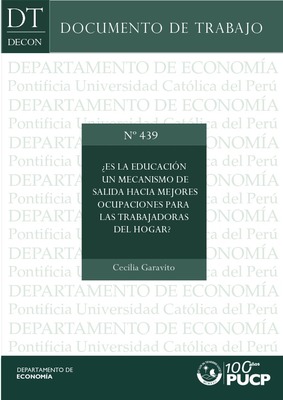| dc.contributor.author | Garavito, Cecilia | |
| dc.date.accessioned | 2018-06-28T15:22:00Z | |
| dc.date.available | 2018-06-28T15:22:00Z | |
| dc.date.issued | 2017-05 | |
| dc.identifier.uri | http://repositorio.pucp.edu.pe/index/handle/123456789/126770 | |
| dc.description.abstract | Nuestro objetivo es analizar si la salida del trabajo del hogar remunerado lleva a mayores ingresos y/o mejores condiciones laborales. Asimismo, analizamos los determinantes de las transiciones laborales entre el empleo, el desempleo y la inactividad, así como entre diferentes ocupaciones. Para ello empleamos los datos de los paneles 2007 – 2011 y 2011 – 2015 de la ENAHO-INEI para el sector urbano. Luego del análisis estadístico y econométrico comprobamos que la salida del trabajo del hogar remunerado (THR) hacia otra ocupación está positivamente asociada a un aumento de los ingresos reales. Asimismo, el nivel de educación es un factor muy importante para salir del THR y para mantenerse en la fuerza laboral. En cuanto a las condiciones laborales, para lo cual empleamos el acceso a ESSALUD como proxy, encontramos que está positivamente asociada con una salida del THR hacia otra ocupación. Finalmente, vemos que si bien la educación tiene un efecto positivo sobre la probabilidad de salir de THR hacia otras ocupaciones, el efecto es mayor en la salida hacia el trabajo independiente, mientras que el efecto del acceso a ESSALUD será mayor en la salida hacia el trabajo obrero.
Our aim is to analyze if leaving paid-house-work for other occupations allows the worker to get a better income and/or labor conditions. We also analyze the determinants of labor transitions between employment, unemployment, and inactivity, and the determinants of transitions between jobs. We work with the panel data 2007 – 2011 and 2011 – 2015 from the ENAHO-INEI, for the urban sector. After the statistical and econometric analysis we find that leaving paid-house-work (PHW) to work on another occupation is positively associated with higher real income. More so, education is a very important determinant of leaving PHW and staying in the labor force. Regarding labor conditions, for which we use the access to ESSALUD as a proxy, we find that it is positively associated with leaving PHW to work on another occupation. Finally, we see that even if education has a positive effect over the probability of leaving PHW for another occupation, the effect is stronger when the new occupation is an independent work, whereas the access to ESSALUD has a higher effect when the new occupation is blue-collar work. | en_US |
| dc.language.iso | spa | es_ES |
| dc.publisher | Pontificia Universidad Católica del Perú. Departamento de Economía | es_ES |
| dc.relation.ispartof | urn:issn:2079-8466 | |
| dc.relation.ispartof | urn:issn:2079-8474 | |
| dc.rights | Atribución-NoComercial-SinDerivadas 2.5 Perú | * |
| dc.rights | info:eu-repo/semantics/openAccess | es_ES |
| dc.rights.uri | http://creativecommons.org/licenses/by-nc-nd/2.5/pe/ | es_ES |
| dc.subject | Género | es_ES |
| dc.subject | Mercado de trabajo | es_ES |
| dc.subject | Oferta de trabajo | es_ES |
| dc.subject | Trabajo del hogar remunerado | es_ES |
| dc.subject | Transiciones laborales | es_ES |
| dc.subject | Gender | es_ES |
| dc.subject | Labor Market | es_ES |
| dc.subject | Labor Supply | es_ES |
| dc.subject | Paid House-Work | es_ES |
| dc.subject | Labor Transitions | es_ES |
| dc.title | ¿Es la educación un mecanismo de salida hacia mejores ocupaciones para las trabajadoras del hogar? | es_ES |
| dc.type | info:eu-repo/semantics/workingPaper | |
| dc.type.other | Documento de trabajo | |
| dc.subject.ocde | http://purl.org/pe-repo/ocde/ford#5.02.00 | |
| dc.publisher.country | PE | |
| renati.advisor.orcid | https://orcid.org/0000-0001-6800-433X | |


